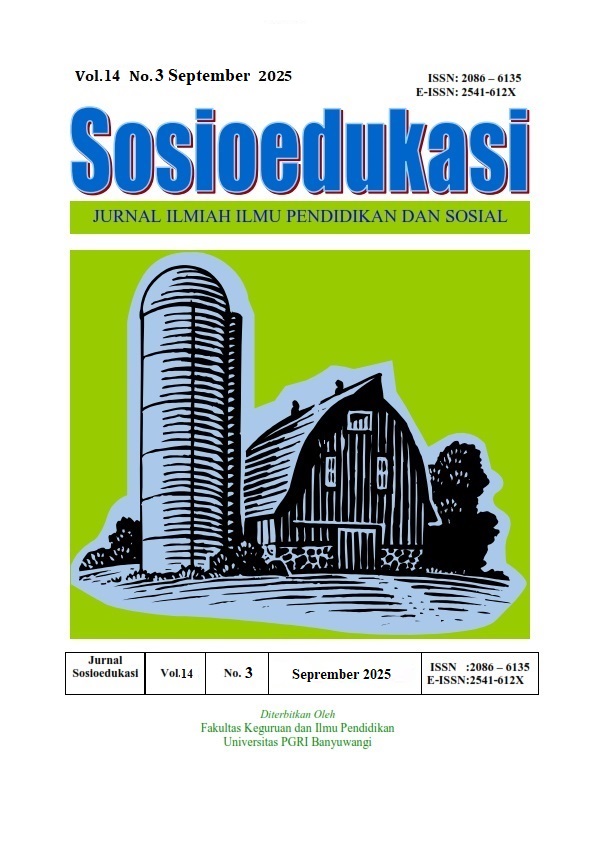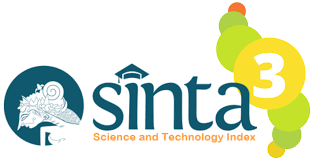DIGITAL RECONSTRUCTION OF HISTORICAL SITES IN BANYUWANGI BASED ON AI AS A TEACHING MEDIUM FOR HIGH SCHOOL HISTORY SUBJECTS IN BANYUWANGI REGENCY
REKONSTRUKSI DIGITAL SITUS SEJARAH DI BANYUWANGI BERBASIS AI SEBAGAI MEDIA AJAR MATA PELAJARAN SEJARAH SMA DI KABUPATEN BANYUWANGI
DOI:
https://doi.org/10.36526/sosioedukasi.v14i3.6124Keywords:
Digital Reconstruction, Local Historical Sites, AI-Based Teaching Media, High School History LearningAbstract
Banyuwangi Regency possesses significant local historical potential through the presence of sites such as Songgon Cave, Wongsorejo Cave, Kalipuro Cave, and the Neolithic Site of Kendenglembu. These resources have not yet been optimally utilised within the history learning process at the upper secondary school level. This study aims to develop a digital instructional medium based on artificial intelligence that reconstructs local historical sites in a visual and educational manner. The research employs a 4D model of Research and Development (R&D), comprising the stages of define, design, develop, and disseminate. The sample includes 200 upper secondary school students selected through stratified purposive sampling. Data collection techniques encompass pre-tests and post-tests, expert validation, observation, and interviews with local community members. The results show that expert validation yielded a feasibility score of 92% and usability of 89%. The students’ pre-test score was 61.4, increasing to 84.7 in the post-test, with an effectiveness value of Cohen’s d at 1.72. The media is deemed highly suitable for use in local wisdom-based history learning. This research recommends further development in integrating virtual reality and enhancing visual data through GIS. AI-based media is expected to reinforce contextual, immersive, and relevant local history learning for the current digital generation.
References
Aljuboori, D., Clary, L. K., Alomairah, S. A., Colder Carras, M., Saquib, N., Saquib, J., … Thrul, J. (2024). Contextual adaptation of digital wellbeing interventions for young people: insights from a project in Saudi Arabia. Frontiers in Psychiatry, 15, 1455962. doi:10.3389/fpsyt.2024.1455962
Arsalan, H., Heesom, D., & Moore, N. (2025). From Heritage Building Information Modelling towards an ‘Echo-based’ Heritage Digital Twin. Heritage, 8(1), 33. doi:10.3390/heritage8010033
Bal, M., & Öztürk, E. (2025). The potential of deep learning in improving K‐12 students’ writing skills: A systematic review. British Educational Research Journal, 51(3), 1295–1312. doi:10.1002/berj.4120
Bouchachi, M., Jiménez-Delgado, A., De-Gracia-Soriano, P., & Nemroudi, R. (2025). Architectural heritage and artificial intelligence: Diagnosis and solutions proposed by ChatGPT for Algerian historical monuments. Heritage, 8(4), 139. doi:10.3390/heritage8040139
Haeruddin, Harimurti, E. R., Harsono, Y., & Fajarianto, O. (2025). Implementation of learning media based on artificial intelligence technology for students of Special School C. Journal of Ecohumanism, 3(8). doi:10.62754/joe.v3i8.5763
Kim, S.-K., Kim, T.-Y., & Kim, K. (2025). Development and effectiveness verification of AI education data sets based on constructivist learning principles for enhancing AI literacy. Scientific Reports, 15(1), 10725. doi:10.1038/s41598-025-95802-4
Liu, B., Zeng, W., Liu, W., Peng, Y., & Yao, N. (2025). AI-enhanced design and application of high school geography field studies in China: A case study of the Yellow (Bohai) Sea migratory bird habitat curriculum. Algorithms, 18(1), 47. doi:10.3390/a18010047
Mader, N., Smith, M., Powell, R., & Pines, A. (2025). School-level support for online advanced placement students: An implementation study of Tennessee’s AP access for all program. PJE. Peabody Journal of Education, 1–22. doi:10.1080/0161956x.2025.2483142
Pathan, Z., & Suhane, S. (2025). Towards documenting and preserving living traditions and heritage: Problems and potentials of emerging digital technologies. ISVS E-Journal, 12(2), 88–100. doi:10.61275/isvsej-2025-12-02-06
Ruiz Viruel, S., Sánchez Rivas, E., & Ruiz Palmero, J. (2025). The role of artificial intelligence in project-based learning: Teacher perceptions and pedagogical implications. Education Sciences, 15(2), 150. doi:10.3390/educsci15020150
Sachyani, D., & Gal, A. (2025). Artificial intelligence tools in environmental education: Facilitating creative learning about complex interaction in nature. European Journal of Educational Research, 14(2), 395–413. doi:10.12973/eu-jer.14.2.395
Sajja, R., Sermet, Y., & Demir, I. (2025). End-to-end deployment of the educational AI hub for personalized learning and engagement: A case study on environmental science education. IEEE Access: Practical Innovations, Open Solutions, 13, 55169–55186. doi:10.1109/access.2025.3554222
Silva, P. (2025). Enhancing adolescent food literacy through Mediterranean diet principles: From evidence to practice. Nutrients, 17(8), 1371. doi:10.3390/nu17081371
Tlili, A., Saqer, K., Salha, S., & Huang, R. (2025). Investigating the effect of artificial intelligence in education (AIEd) on learning achievement: A meta-analysis and research synthesis. Information Development. doi:10.1177/02666669241304407
Tu, T., Schaekermann, M., Palepu, A., Saab, K., Freyberg, J., Tanno, R., … Natarajan, V. (2025). Towards conversational diagnostic artificial intelligence. Nature, 642(8067), 442–450. doi:10.1038/s41586-025-08866-7
Wang, Y., & Zhou, Y. (2025). Artificial intelligence-driven interactive experience for intangible cultural heritage: Sustainable innovation of Blue Clamp-Resist Dyeing. Sustainability, 17(3), 898. doi:10.3390/su17030898
Wilson, S. E., Wiggins, J. B., Wong, L. N., Ulrich, T. G., Causey, B., Parra, J., … Blackorby, J. (2025). Leveraging design-Based Research in the development of a technology-based intervention for students with disabilities. Journal of Special Education Technology, 40(2), 195–207. doi:10.1177/01626434251317989
Younas, M., Abdel Salam El-Dakhs, D., & Jiang, Y. (2025). A comprehensive systematic review of AI-driven approaches to self-directed learning. IEEE Access: Practical Innovations, Open Solutions, 13, 38387–38403. doi:10.1109/access.2025.3546319
Zhao, Y., Li, Y., Dai, T., Sedini, C., Wu, X., Jiang, W., … Lc, R. (2025). Virtual reality in heritage education for enhanced learning experience: a mini-review and design considerations. Frontiers in Virtual Reality, 6. doi:10.3389/frvir.2025.1560594









.png)

















